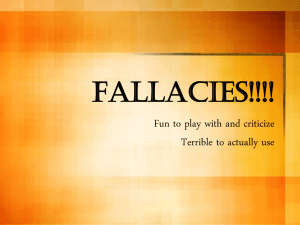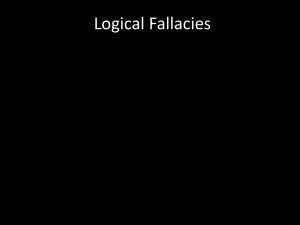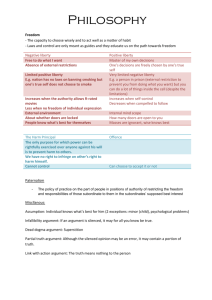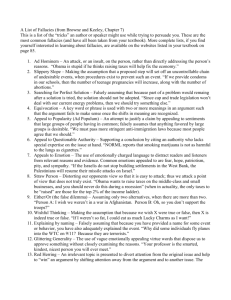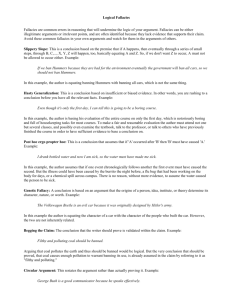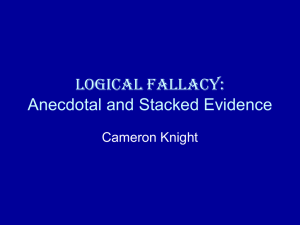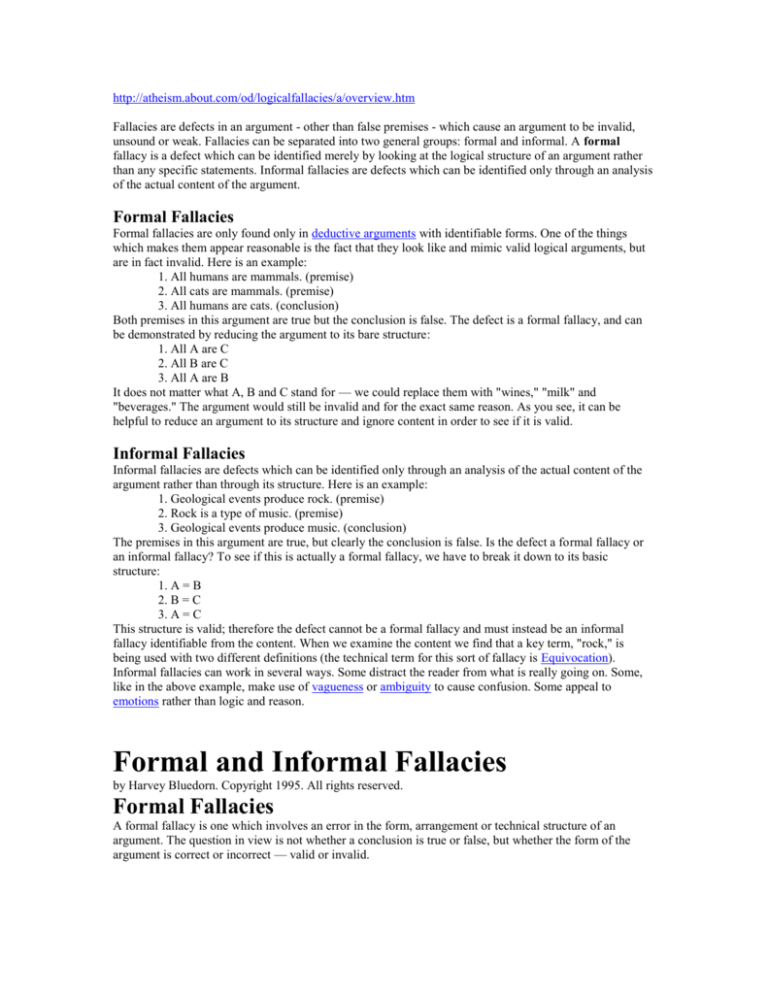
http://atheism.about.com/od/logicalfallacies/a/overview.htm
Fallacies are defects in an argument - other than false premises - which cause an argument to be invalid,
unsound or weak. Fallacies can be separated into two general groups: formal and informal. A formal
fallacy is a defect which can be identified merely by looking at the logical structure of an argument rather
than any specific statements. Informal fallacies are defects which can be identified only through an analysis
of the actual content of the argument.
Formal Fallacies
Formal fallacies are only found only in deductive arguments with identifiable forms. One of the things
which makes them appear reasonable is the fact that they look like and mimic valid logical arguments, but
are in fact invalid. Here is an example:
1. All humans are mammals. (premise)
2. All cats are mammals. (premise)
3. All humans are cats. (conclusion)
Both premises in this argument are true but the conclusion is false. The defect is a formal fallacy, and can
be demonstrated by reducing the argument to its bare structure:
1. All A are C
2. All B are C
3. All A are B
It does not matter what A, B and C stand for — we could replace them with "wines," "milk" and
"beverages." The argument would still be invalid and for the exact same reason. As you see, it can be
helpful to reduce an argument to its structure and ignore content in order to see if it is valid.
Informal Fallacies
Informal fallacies are defects which can be identified only through an analysis of the actual content of the
argument rather than through its structure. Here is an example:
1. Geological events produce rock. (premise)
2. Rock is a type of music. (premise)
3. Geological events produce music. (conclusion)
The premises in this argument are true, but clearly the conclusion is false. Is the defect a formal fallacy or
an informal fallacy? To see if this is actually a formal fallacy, we have to break it down to its basic
structure:
1. A = B
2. B = C
3. A = C
This structure is valid; therefore the defect cannot be a formal fallacy and must instead be an informal
fallacy identifiable from the content. When we examine the content we find that a key term, "rock," is
being used with two different definitions (the technical term for this sort of fallacy is Equivocation).
Informal fallacies can work in several ways. Some distract the reader from what is really going on. Some,
like in the above example, make use of vagueness or ambiguity to cause confusion. Some appeal to
emotions rather than logic and reason.
Formal and Informal Fallacies
by Harvey Bluedorn. Copyright 1995. All rights reserved.
Formal Fallacies
A formal fallacy is one which involves an error in the form, arrangement or technical structure of an
argument. The question in view is not whether a conclusion is true or false, but whether the form of the
argument is correct or incorrect — valid or invalid.
The concluding statement of an argument may be objectively true, though the argument is formally invalid;
or the concluding statement may be objectively false, though the argument is formally valid. Here are some
examples:
Formally Valid Arguments:
1. True and Valid:
All men are mortal.
Socrates is a man.
Therefore Socrates is mortal.
2. False but Valid:
All men are green.
Socrates is a man.
Therefore Socrates is green.
Formally Invalid Arguments:
3. False and Invalid:
Some men are green.
Socrates is a man.
Therefore Socrates is green.
4. True but Invalid:
Some men are mortal.
Socrates is a man.
Therefore Socrates is mortal.
In example 2, the first statement is false, but the form or structure of the argument is correct or valid. (If all
men were green; then Socrates would be also.)
In examples 3 and 4, the first statement says something about some men, not about all men. One could
correctly reason from this first statement that Socrates might possibly be green or mortal, but he could not
correctly reason that Socrates necessarily is green or mortal.
Formal fallacies are therefore invalid arguments — arguments where the concluding statement does not
necessarily follow from the statements preceding it. The concluding statement may actually be objectively
true, but it's truth does not depend on or follow from the other statements.
A change in the actual terms used in an argument may affect the actual truth value of the argument, but a
change in terms will not affect the validity or invalidity of the argument. All men including Socrates are
truly mortal; but all men including Socrates are not truly green. If all men were green, then Socrates would
be also! But if only some men were green, then Socrates would not necessarily be green.
Because the terms themselves do not affect validity, we can substitute symbols for the terms.
All men are mortal. All a are b.
Socrates is a man. c is a.
Therefore Socrates is mortal. Therefore c is b.
No matter what terms you may put in the place of a, b, and c, if all a are members of the class called b, and
c is a member of the class called a, the c must necessarily be a member of the class called b.
Because there are only a small number of possible relationships between the terms, these relationships can
also be represented by symbols. When this is done, the whole form of an argument can be written in
symbols. This is called symbolic logic, which is a special branch of the study of formal validity.
Informal Fallacies
Correct reasoning involves clear expression and valid form. Formal fallacies are a matter of invalid form.
Informal fallacies are a matter of unclear expression. Formal fallacies deal with the logic of the technical
structure, while informal fallacies deal with the logic of the meaning of language. The word "informal"
does not here mean it is inferior, casual or improper. It only means that our focus is not on the form of the
argument, but on the meaning of the argument.
An informal fallacy involves such things as: the misuse of language — words or grammar, misstatements
of fact or opinion, misconceptions due to underlying presuppositions, or just plain illogical sequences of
thought.
We encounter both formal and informal fallacies every day, but unlike formal fallacies, we cannot reduce
informal fallacies to symbolic formulas. We can, however, compile a list of characteristic profiles of
informal fallacies, and arrange them into general categories.

